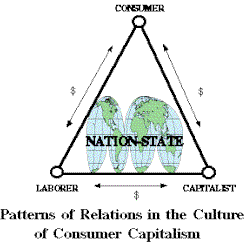Readings on the Consumer
|
|||
| A. The History and Nature of Consumerism | |||
| In
Global Problems and the Culture of Capitalism we suggest that the
emergence of the consumer represents a unique development in the
history of the human species. The following articles discuss this
development in the United States. |
|||
|
Reading
1.
State of the World Trends and Facts: The State of Consumption Today http://www.worldwatch.org/features/consumption/sow/trendsfacts/2004/02/04/ |
|||
| An overview of the material on global consumption contained in the Worldwatch Institute's publication, State of the World 2004. The overview contains information on the growth of global consumption, inequalities in production, and the social and environmental problems created by the growth in consumption. | |||
| Reading 2.
The History of Affluenza in America http://www.pbs.org/kcts/affluenza/diag/history.htm |
|||
 |
To accompany its documentary on the history of consumption, or affluenza, as they called it, PBS developed this timeline of the development of consumerism. Read each stage of the process and learn, not only about key developments in the history of consumerism in the United States, but also about the periodic resistance to it. Later you will have an opportunity to check the extent to which you are infected with affluenza. | ||
| Reading 3
Washed Up http://www.gristmagazine.com/counter/counter120502.asp |
|||
| Our culture often masks from us the consequences of some of our most simple acts. Take washing our clothes, for example. How much water do you think you use to keep your dresses, slacks, shirts and other items of apparel "sparkling clean"? This brief set of statistics from Grist Magazine should give you some idea. | |||
| B. Turning People into Consumers | |||
| People have, of course, always consumed things,
either making these things themselves, bartering or trading for them,
or purchasing them at markets. But it is only in the past few
centuries, and largely in the past 100 years, that mass consumption
has become an essential ingredient of our culture. Furthermore, as we
discuss in
Global Problems and the Culture of Capitalism people are
not naturally consumers; consumers had to be created. The following
articles discuss how people, particularly children, are transformed
into consumers. |
|||
| Reading 4.
Consuming Kids http://www.rprogress.org/publications/gpi1999/consuming_kids.html |
|||
| As this article from Redefining Progress points out, children learn the ABCs of consumption long before they learn how to read and write. The article describes some of the ways that children are turned into consumers, and how important children have become for our economy. But it also explores some of the effects of consumption on children, and how the economic capital they generate comes at a cost of social capital. | |||
| Reading 5. How Do Our Kids Get Caught Up in Consumerism? http://www.newdream.org/newsletter/swimme.php | |||
| In Global Problems and the Culture of Capitalism we describe how the meaning of childhood was transformed in the United States in order to turn children into a key segment of the consuming public. In this article Brian Swimme maintains that "Advertisements are where our children receive their cosmology, their basic grasp of the world's meaning, which amounts to their primary religious faith, though unrecognized as such.... The advertisement is our culture's primary vehicle for providing our children with their personal cosmologies." See if you agree. | |||
| Reading 6.
Zapme! A New Corporate Predator in the Schools http://www.commercialalert.org/index..... |
|||
| This press release from Commercial Alert, an organization devoted to exposing the dangers of advertising to children, describes some recent attempts by corporations to infiltrate schools. This is not the first, nor is it likely to be the last, attempt. Corporations and advertisers have long been interested in getting access to this captive audience in a setting in which their message is imbued with the legitimacy of our educational institutions. | |||
|
Reading
7.
The Fast Food Trap: How Commercialism Creates Overweight Children http://www.commercialalert.org/issues-article.php?article_id=236&subcategory_id=72&category=5 |
|||
| This article by Gary Ruskin discusses the rise of childhood obesity in America. Childhood, says Ruskin, has been redefined by American commercial culture to make children increasingly vulnerable to corporate marketing. The corporate redefining of childhood, says Ruskin, "employed four main tools: television, the marketing of junk food, the commercial takeover of the schools, and the starvation of the public sector." These factors, combined with the decreasing influence of parents over their children has resulted in, among other things, the fattening of American children. At the end of the article, Ruskin lays out some actions that parents and others can take to deal with the problem. You also need to be aware that the food industry has its own campaign to convince people that "food freedom" is under attack, and that scientific studies that indicate that obesity is a problem are flawed. Check out the website for the Center for Consumer Freedom, particularly the section on food police. The website is a good example of how industry responds when their interests are threatened, | |||
| C. The Consequences of Consumerism | |||
| One of the essential features of the culture of
capitalism is masking from the consumer the effects of his or her
consumption patterns. Yet the effects are far-reaching; our patterns
of consumption influence virtually every facet of our lives, from the
way we allocate our time, to the nature of our social relations, to
the state of our environment, even the meaning of our bodies. The
following articles discuss some of these effects. |
|||
| Reading 8.
Waste a Lot,Want a Lot: Our All-Consuming Quest for Style http://www.bconnex.net/~cspcc/empathic_parenting/waste.htm |
|||
| How do you drive people to consume? One way is to ensure that they are dissatisfied with what they have, make them, in effect, slaves to style. In this article, Stuart Ewen traces the history of style in America, and discusses some of the consequences of this for our society. | |||
| Reading 9.
Inside the Mouse: Deconstructing Disney http://www.dukemagazine.duke.edu/alumni/dm1/inmouse.txt.html |
|||
| In her edited volume on Walt Disney World, Susan Willis asks about the "kind of social realities we develop in an artificial environment based on consumption. What does it mean for our social relationships?" This review of the book, Inside the Mouse: Deconstructing Disney, and interview with Susan Willis outlines some of the answers to that question. | |||
| Reading 10:
The
New Cannibalism http://www.newint.org/issue300/trade.html |
|||
| In the culture of capitalism virtually everything is available only as a commodity, that is something to be bought or sold. The neccesities of life, for example, such as food, shelter, and health care, exist only as commodities; without the means to "buy" them, people starve, are homeless, or do without medical treatment. Even our bodies, as this article from New Internationalism by Nancy Scheper-Hughes illustrates, are becoming commodified. She describes the booming market in human organs, as increasingly impoverished peoples sell their body parts for transplants to rich buyers. The results are the reduction of the human body to bits and parts that can be bought or sold on increasingly globalized markets, and, in some countries, a terrified citizenry that fears they will be killed for their organs. | |||
| Reading 11.
Emulation and Global Consumerism http://www.indiana.edu/~wanthro/nrc2.html |
|||
| At the end of the first chapter of Global Problems and the Culture of Capitalism, we pose the question of what happens when the rest of the world tries to emulate the consumption patterns characteristic of the culture of capitalism? In this article, Richard Wilk discusses the reality of that prospect, and offers some suggestions for other scenarios. | |||
| D. How Badly are you Infected with Affluenza? | |||
| It is sometimes difficult for us to appreciate
the extent to which our behavior is a consequence of what we really
want to do, and how much is a consequence of our culture. In Global
Problems and the Culture of Capitalism we use the analogy of the
Navaho sandpainting to illustrate the extent to which our culture
determines our behavior. This exercise is designed for you to discover
the extent to which you are embedded in the sandpainting of the
culture of capitalism. |
|||
| Exercise 1.
Reverend Billy and the Church of
Stop Shopping http://www.revbilly.com/ |
|||
| Reverend Billy and his Church of Stop Shopping is devoted to bringing the message of the dangers of consumerism to whoever will listen. At the site you can get all kinds information (and links), as well as the movie, Preacher with an Unknown God. | |||
| Exercise 2.
Do you have affluenza? http://www.pbs.org/kcts/affluenza/diag/have.html |
|||
| Take this test yourself and see to what degree you're infected with affluenza. | |||

